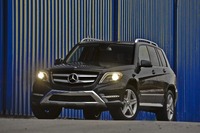2014 Mercedes GLK-Class BlueTEC (Diesel) Review By Thom Cannell
By Thom Cannell
Senior Editor
Michigan Bureau
The Auto Channel
No one has offered diesel cars in the US longer than Mercedes. Their latest diesel, the 2014 GLK-Class, gets an updated exterior, interior, and a diesel engine that costs less than the premium V-6—while delivering better fuel economy and more torque.
We’re very excited about this new-to-North America engine as it will soon power the new CLA-Class where the 200 horses and 369 kick-butt pounds of torque will make it an economy hot rod. But back to today, with a historical sidetrack for Mercedes-Benz can reasonably claim to have invented the diesel passenger car having delivered its first in 1936. It brought the memorable 170D to the US in 1949 and continued to deliver diesel passenger cars almost every year since.
 |
 |
 |
 |
 |
We discussed these changes with M-B executives, who say that globally, the movement is from counting cylinders to regarding luxury as an experience, one that engine downsizing does not affect as long as appropriate power is delivered. For instance this tiny engine delivers the same torque as a normally aspirated V-8 engine modified by in-house tuner AMG (think money, power, control) did just five years ago.
We also asked if their increasingly cutting edge designs were an advantage, or could high design lead to a shorter lifetime compared to a more sedate and classic style? Product Manager Bart Herring told us “We study the impact of design and you have to grow, look for something new without abandoning the old… understanding what people appreciate about your design that makes them think that's what a Mercedes Benz should be. What we found is that (we could be) more dynamic and more aggressive without losing those traditional customers. You see, it is a calculated exercise in bringing the brand forward for this new customer while maintaining M-B values in reputation. Brand is one of the greatest reasons for purchase, design is close behind. We feel like it is a success as it feels like a Mercedes when you drive it, but it has a more dynamic look.”
 |
Our first impression of the car was of little noise, though parked next to a building. That old diesel knock was totally missing—and we don’t miss it! The second thing, once we’d stepped on the “gas”, was torque, more torque, and even more torque! The GLK really moves you forward at any speed, mostly without a kick-down. Interestingly, and obviously for fuel economy, you can’t easily get the seven-speed transmission to downshift several gears if you floor the throttle.
Steering is very self-centering in a way some of us find somewhat rubbery. Very stiff rubber, like the black tubing at the health club and not wimpy. Nonetheless, until over 50 mph it feels modestly heavy, rather like bending a wooden bow or the first pull on a compound bow.
Road manners on poor surfaces are tasty, firm with dual stages to let minor imperfections glide by rather than jar. Over some really rough road we felt compression and rebound that’s very well controlled and solid.
 |
I may have had reservations about the Navigation but it clearly showed the map, splitting the screen to show any directional turn, often providing a sliding bar graph to show proximity to the turn. I call that belt, suspenders, and safety pins. So a very pleasant car to drive, one you could quickly adapt to with ease and we look forward to our scheduled extended test.



